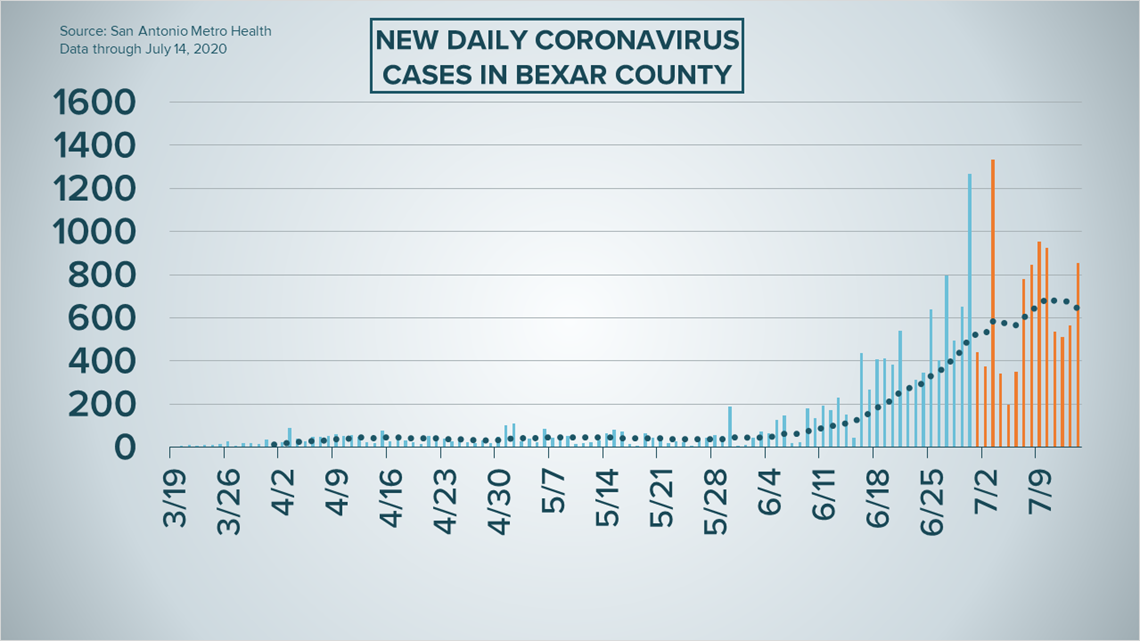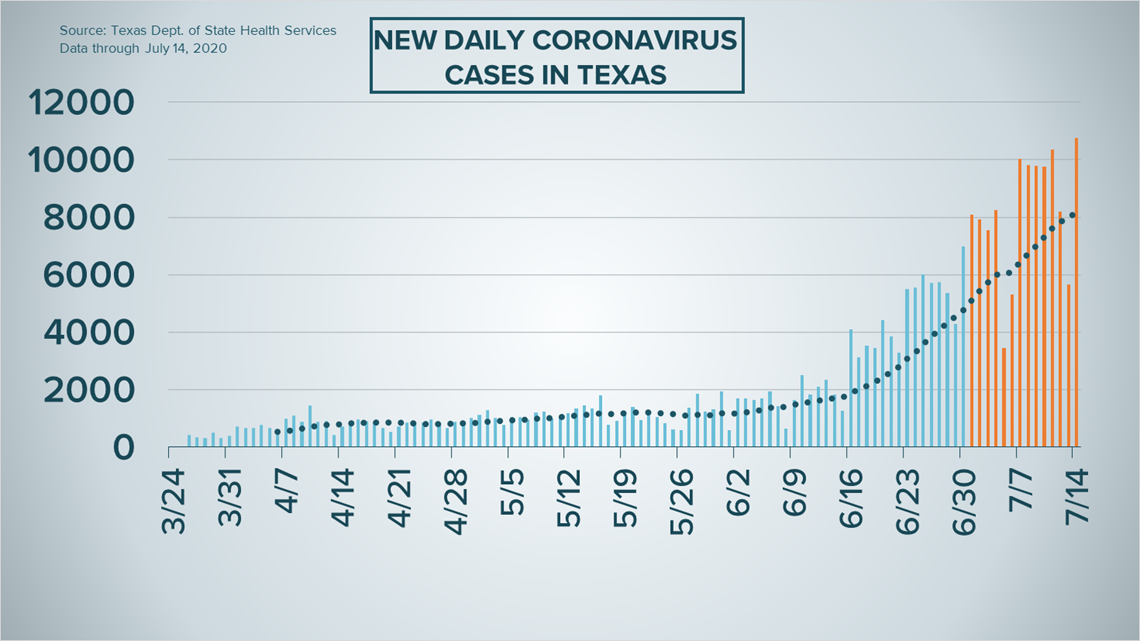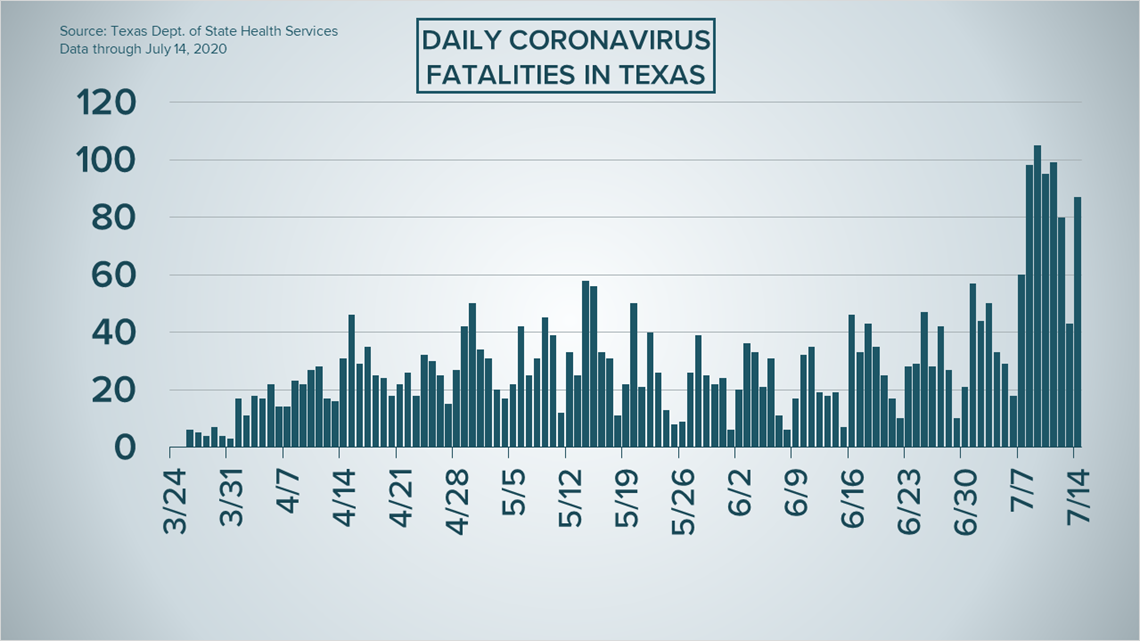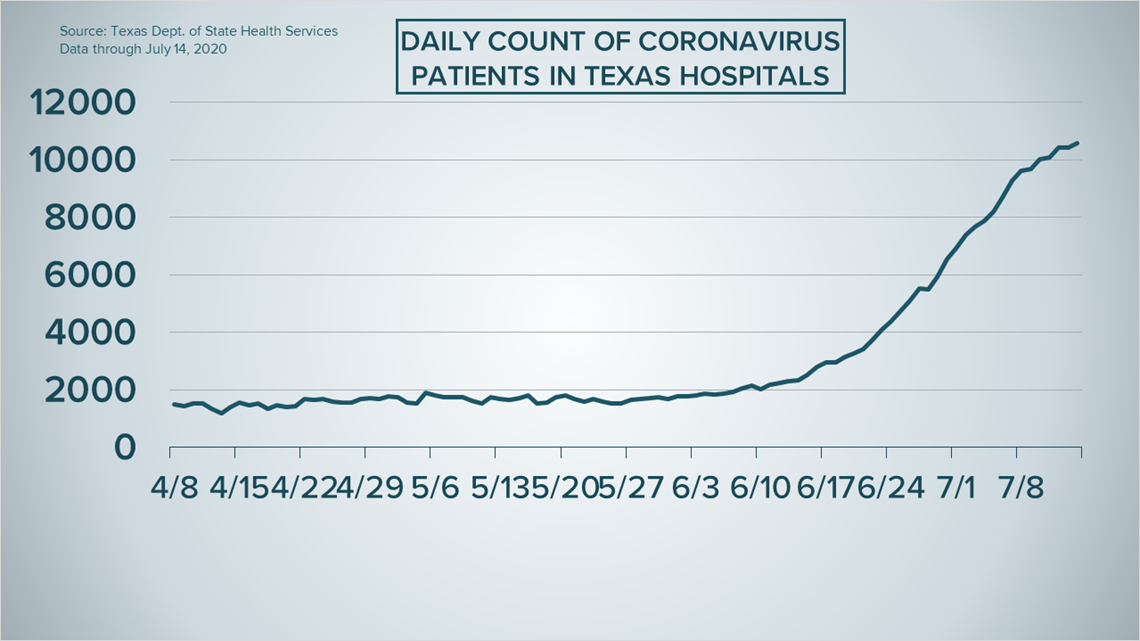SAN ANTONIO — We're tracking the latest numbers from the coronavirus pandemic in San Antonio and across Texas. Here are the latest numbers reported by Bexar and surrounding counties:
- Bexar County: 854 new cases and six fatalities from COVID-19 were reported Tuesday. There have been a total of 21,067 cases and 201 virus-related fatalities in the county.
- Comal County: Comal County confirmed seven coronavirus deaths over the weekend. 29 county residents have died since the COVID-19 pandemic began. The county also reported 67 new cases Tuesday. 1,349 total coronavirus cases have been confirmed in Comal County; 458 residents have recovered.
- Hays County: Two more virus-releated deaths in the county were reported Tuesday, along with 56 more cases. As of July 14, the Hays County Local Health Department confirms there are at least 2,942 active lab-confirmed cases of COVID-19. Since Hays County first started providing numbers, a total of 3,699 lab-confirmed cases have been reported, including 13 deaths.
How Bexar County is trending:
We're tracking how many coronavirus cases are confirmed in Bexar County each day from the time San Antonio Metro Health began reporting cases more than two months ago. Graphing those daily case numbers along a 14-day moving average provides an accurate picture of the curve in the San Antonio area and the direction we're heading amid the coronavirus.
On Tuesday, Mayor Ron Nirenberg reported an additional 854 coronavirus cases in Bexar County, bringing the total to 21,067. Six more virus-related deaths were also reported, raising the death toll to 201.


Meanwhile, Bexar County continues its trend of having more than 1,000 residents hospitalized with COVID-19, with 1,237 receiving treatment on Tuesday. 260 patients are on ventilators, while 417 are in intensive care.


Coronavirus in Texas
Health officials reported 10,745 newly confirmed coronavirus cases Tuesday – an unfortunate new high for the Lone Star State – along with 87 additional virus-related deaths. Those figures bring the statewide totals to 275,058 COVID-19 cases and 3,322 deaths.
Tuesday marks the second day in the last week with at least 10,000 new cases. The figure of 87 deaths is also one of the highest totals for the state in this pandemic.




Another 164 COVID-19-positive patients were also admitted to Texas hospitals over the last 24 hours; a total of 10,569 residents are receiving treatment Tuesday. The number of available intensivue care unit beds ready to take a patient, meanwhile, has dropped below 10%.


Latest Coronavirus Headlines
- Number of ICU hospital beds in Texas drops below 10%
- Studies show coronavirus antibodies may only last a few months
- 1st COVID-19 vaccine in US boosted immune systems; headed to final test stage
- Texas hospitals are running out of drugs, beds, ventilators and even staff
- White House turns on Dr. Fauci as President Trump minimizes virus spike
- What is contact tracing, and how does it work with COVID-19?
- 'Please take this virus seriously' | Rockets guard Russell Westbrook tests positive for COVID-19
Coronavirus symptoms
The symptoms of coronavirus can be similar to the flu or a bad cold. Symptoms include fever or chills, cough, shortness of breath or difficulty breathing, fatigue, muscle or body aches, headache, new loss of taste or smell sore throat, congestion or runny nose, nausea or vomiting and diarrhea, according to the Centers for Disease Control.
Most healthy people will have mild symptoms. A study of more than 72,000 patients by the Centers for Disease Control in China showed 80 percent of the cases there were mild.
But infections can cause pneumonia, severe acute respiratory syndrome, kidney failure, and even death, according to the World Health Organization. Older people with underlying health conditions are most at risk.
On June 25, the CDC expanded the list of groups at a higher risk of severe illness due to coronavirus.
Experts determined there was consistent evidence these conditions increase a person's risk, regardless of age:
- Chronic kidney disease
- COPD (chronic obstructive pulmonary disease)
- Obesity (BMI of 30 or higher)
- Immunocompromised state (weakened immune system) from solid organ transplant
- Serious heart conditions, such as heart failure, coronary artery disease, or cardiomyopathies
- Sickle cell disease
- Type 2 diabetes
The CDC believes symptoms may appear anywhere from two to 14 days after being exposed.
Human coronaviruses are usually spread...
- Between people who are in close contact with one another (within about 6 feet).
- Through respiratory droplets produced when an infected person coughs, sneezes or talks. These droplets can land in the mouths or noses of people who are nearby or possibly be inhaled into the lungs.
- Some recent studies have suggested that COVID-19 may be spread by people who are not showing symptoms.
Help stop the spread of coronavirus
- Stay home when you are sick.
- Eat and sleep separately from your family members
- Use different utensils and dishes
- Cover your cough or sneeze with your arm, not your hand.
- If you use a tissue, throw it in the trash.
Lower your risk
- Wash your hands often with soap and water for at least 20 seconds. If soap and water are not available, use an alcohol-based hand sanitizer.
- Avoid touching your eyes, nose, and mouth with unwashed hands.
- Avoid close contact with people who are sick.
- Clean and disinfect frequently touched objects and surfaces.
- The CDC recommends wearing a mask or cloth face covering if you have to be out due to an essential service or essential activity such as going to the grocery store.
- If you are 60 or over and have an underlying health condition such as cardiovascular disease, diabetes or respiratory illnesses like asthma or COPD, the World Health Organization advises you to try to avoid crowds or places where you might interact with people who are sick.

